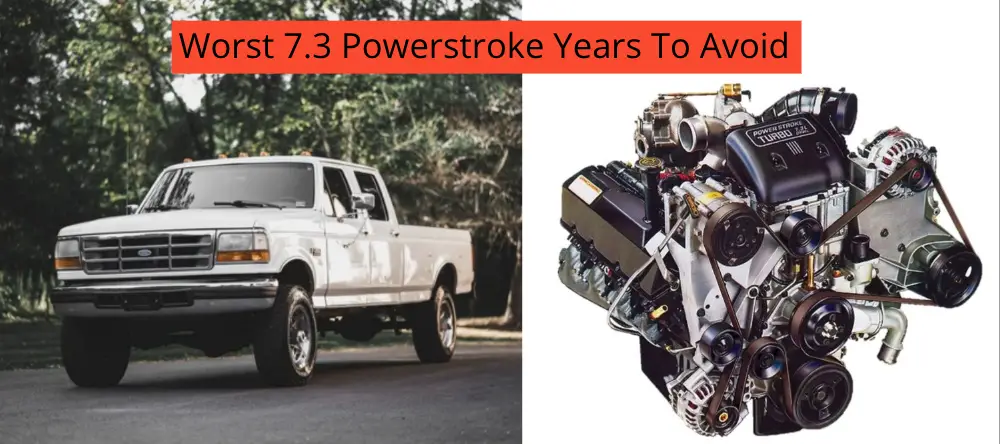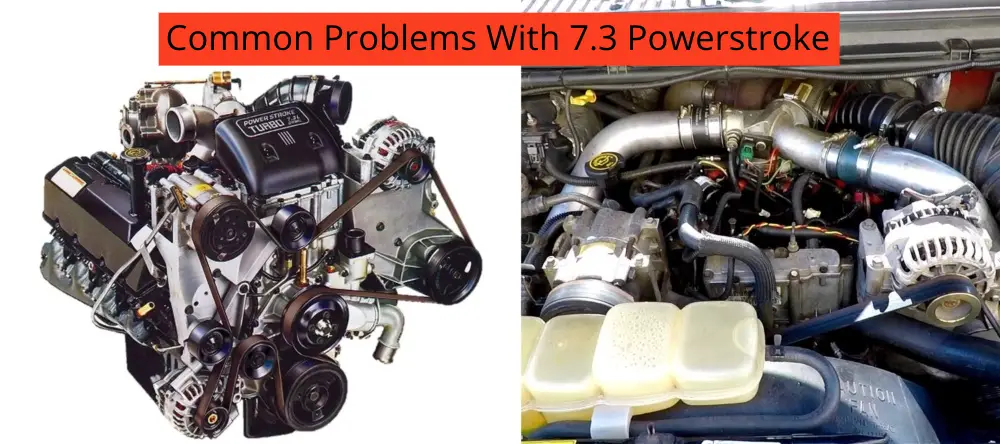
While generally, the Powerstroke has proven to be a competent engine, some versions hold more problems than others.
When car owners purchase haphazardly, they end up being shocked at the number of complications. Your best choice is to know which versions are better avoided.
The 1994, 1999, 2000, and 2002 versions of the Powerstroke 7.3L should be avoided. These models tend to have issues with injectors, oil leaks, camshaft position sensors, and heating regulation. Some problems, however, are near universal with 7.3 Powerstrokes.
This article will discuss the versions of the Powerstroke 7.3L with the most problems and why those problems manifested. It will then bring up some common issues in most Powerstroke engines.
1. 1994 7.3 L Powerstroke
As you may know, 1994 was the year of the Powerstroke’s debut. As such, it is anticipated to have quite a few problems.
Among the most notable was the often faulty camshaft position sensor. When this component is defective, the combustion chamber receives an inappropriate amount of fuel, leading to failed combustion reactions.
The CPS’ role is to take note of the positioning of the cams, which it reports to the PCM, for maximum fuel efficiency and reduced carbon emissions. So if you have this vehicle, expect bad fuel economy and rising emissions due to faulty CPS.
The one thing, though, is this type of sensor tends to be cheap and can be replaced easily. So if you are patient and have a lot of time to spare going to an auto mechanic, the 1994 model won’t be too much of a headache for you.
Reasons To Avoid:
- Fragile Camshift Position Sensor
2. 1999 7.3 L Powerstroke
Among the more common issues with the 1999 model is that it sometimes would have low injector control pressure and power. Given these conditions, you can expect the engine to perform poorly.
It is also common to experience low-end power during cruising which could be caused by a failure to boost due to a leak or injectors that have worn out. Among the primary selling points of the Powerstroke is its boosting mechanisms, which are highly influenced by the injectors.
So if you expect solid boosts for the Powerstroke, you may not get it with the 1999.
Injectors would sometimes even break to the point of causing blockages to other components. So if you see a 1999 suddenly stalling and emitting smoke, it could be because of an injector part getting into the chambers or even the rotating assembly.
The engine components are also quite prone to wear even when the engine is fueled. For this reason, you may hear some engine sounds while driving or even idling. Some car owners would characterize it as a “misfiring” sound.
The sounds may be due to the injectors being opened too early.
Watch out for the non-engine parts, too, as they sometimes have problems. Sometimes the pedal would be unresponsive, and the check engine light would just turn on randomly.
Reasons To Avoid:
- Low ICP
- Weak Boosters
- Prone To Leaky Injectors
- Fragile Pedal
3. 2000 7.3 L Powerstroke
With the 2000, a common problem is how quickly things would heat up. The upgrade from the 1999 may have been too drastic to the point that mechanisms were not installed to avoid the melting of materials.
A common reason for performance issues is a faulty powertrain control module (PCM). You can often see these signs through idle loping or insufficient acceleration power. Much like the 1999, faulty injectors may be the problem.
A short from the injectors may be sending excessive voltage to the IDM housing, which unnecessarily heats up the component.
Reasons To Avoid:
- Bad Heat Regulation Mechanisms
4. 2002 7.3 L Powerstroke
In the 2002 version, it is also fairly common to see the fuel leak. It’s common to see the oil gauge go up only for it to reread 0 once a certain rotation per minute (rpm) count is reached.
Aside from the ICP leak, another common culprit is on the gauge itself. Fuel from the low-pressure oil pump would sometimes fill the high-pressure oil pump reservoir, and the gauge thinks this is normal.
Sometimes, oil would even get into the exhaust manifold. This is because of a leaky cylinder.
It would be best if you also looked out for issues with the batteries. Sometimes, the alternator of the 2002 model would not charge at all, even demonstrating voltages as low as 11.9 volts. This may be due to faulty wiring in the model or a problem with the PCM itself.
The alternator, after all, will not engage if it does not get the command from the PCM.
Like the 1999 model, the 2002 model is also prone to mechanical wear, especially on the injectors. It is common to see smoke coming out of the engine. This happens when o-rings have become worn out and dry rotten.
Reasons To Avoid:
- Leaky Cylinders
- General Oil Issues
- Faulty Alternator
- Faulty Injectors
Common Problems With 7.3 Powerstroke Engines

At this point, I assume you would have decided to avoid the years I mentioned above. Sadly, there are certain vehicle problems that almost all Powerstroke Engines tend to encounter regardless of the year.
So if you really are dead set on the 7.3, here’s what you need to prepare for:
Faulty Camshaft Positioning Sensor
Unfortunately, Ford hadn’t completely worked out how to install a durable camshaft positioning sensor even up to the 2003 model.
As a result, the control module would often get no or erroneous reports, which often lead to an inappropriate amount of fuel being injected into the combustion chambers.
Prepare for episodes of stalling, surging, and even false starts with this problem, as these are most likely rooted in a bad fuel amount.
This is why I would advise you to keep spare CPS on your dashboards. Ask any mechanic who has dealt with Powerstrokes, and they will tell you that a faulty CPS is a prevalent problem.
Faulty Injector Cups
One of the places that diesel shouldn’t be getting into is your vehicle’s coolant chambers. Usually, you can test whether diesel has gotten in by simply smelling the coolant. This is most definitely a sign of faulty injector cups.
These cups create a boundary between the cylinder heads and the coolant. When mixed in diesel, it would often cause the coolant to gel up, dramatically damaging your engine.
Overheating Engine
The main culprit for this is the debris that somehow gets into the radiator. The Powerstroke has several components which rely on the air intake, and the transmission from component to component allows for the sucking in of foreign material.
When this clogs up the radiator, the temperature is harder to regulate. Luckily, this can easily be remedied by a power washer.
Episodes Of Jerking And Surging
Due to years of use, it’s much expected for the wires of your Powerstroke to experience issues. There will be tears, cracks, and voltage leaks which will cause engine components to malfunction.
Often, car owners would blame the components themselves for the issues without acknowledging it may be the wires traveling to and from the components. A way to counter this would be to use wire harnesses.
These harnesses tend to be a bit pricey, but they do make your car run a lot smoother.
Faulty Injector Control Pressure Sensor
The injector control pressure (ICP) sensor monitors the amount of fuel traveling through the injector pipes. When this is faulty, it gives out inaccurate readings to the PCM. Unfortunately, the PCM operates based on these readings.
Suppose excessive or insufficient fuel is churned out by the injectors. In that case, you can definitely expect the engine to misfire or the vehicle to stall, idle or surge.
Air-Conditioner Blowing Hot Air
When the AC suddenly blows hot air, this is most likely due to the rubber connectors going bad over time. They can no longer prevent heat transfer from the engine and onto the air conditioning.
To remedy this, you can simply replace the rubber connectors.
Rusty Exteriors
The Powerstroke generally has a very smooth finish and a clean-looking appearance. Still, it is common to see rusting issues, particularly along the wheels and on the front of the vehicle.
You cannot rely on paint jobs for too long, so it would be better to invest in anti-rusting mechanisms to maintain your vehicle’s sleek appearance.
Leaks On The Up Pipe
The primary culprit with this is often the bolts near the manifold. They break very easily. Several factors damage these bolts, including the heat, the weather, which causes rust, and even the sudden brakes of your vehicle.
Fixing this is very straightforward; you have to get new bolts. The up pipe is easily reached if you go underneath your vehicle. You can even do these during routine check-ups, such as oil changes and checking for faulty brakes.
Alternator Burnout
Alternators don’t usually burn out quickly on regular vehicles, so if you notice it on your Powerstroke, it’s most likely due to faulty battery connections.
Detach those wires and get them cleaned. Often, foreign materials would get into the connection preventing a consistent stream of voltage transfer.
Final Thoughts
The Powerstroke generally, is still very much a solid and durable vehicle. Still, some models tend to outperform others, and if you want the best bang for your buck, you would want to get only the models with the least problems.
Do note, however, that even if you avoid the years mentioned above, you’d still be prone to problems particularly if you don’t show much love and affection to your Powerstroke vehicle.
